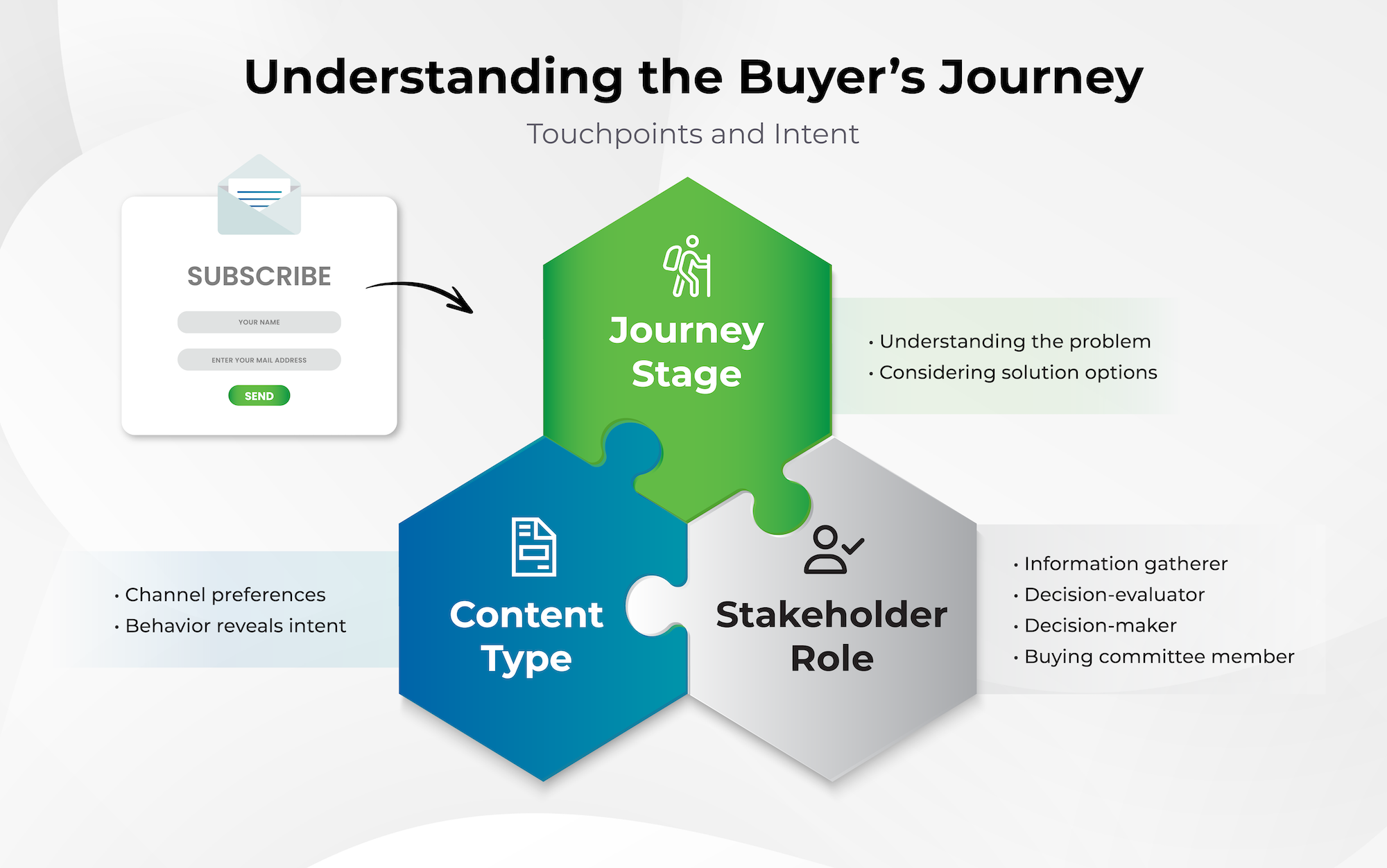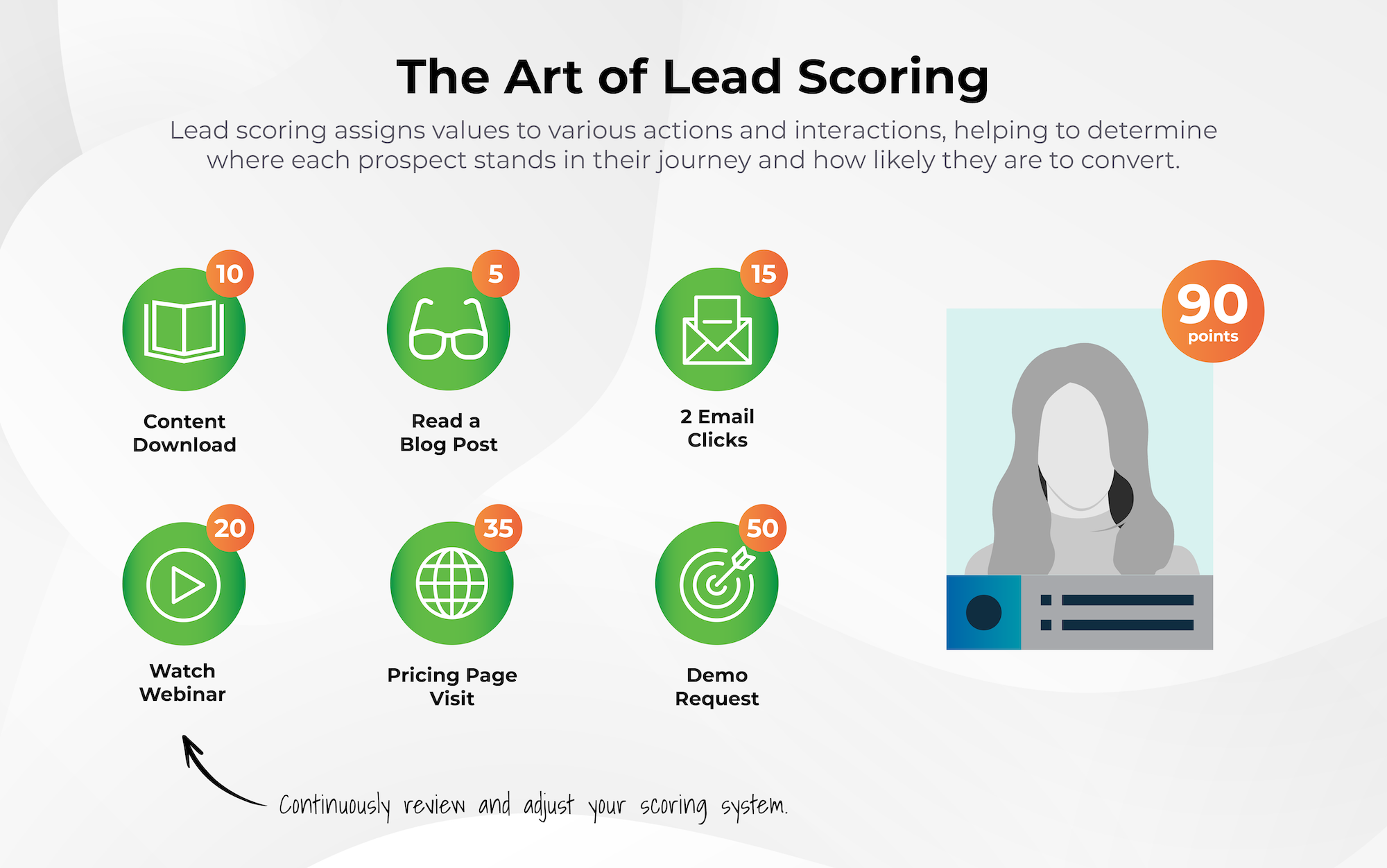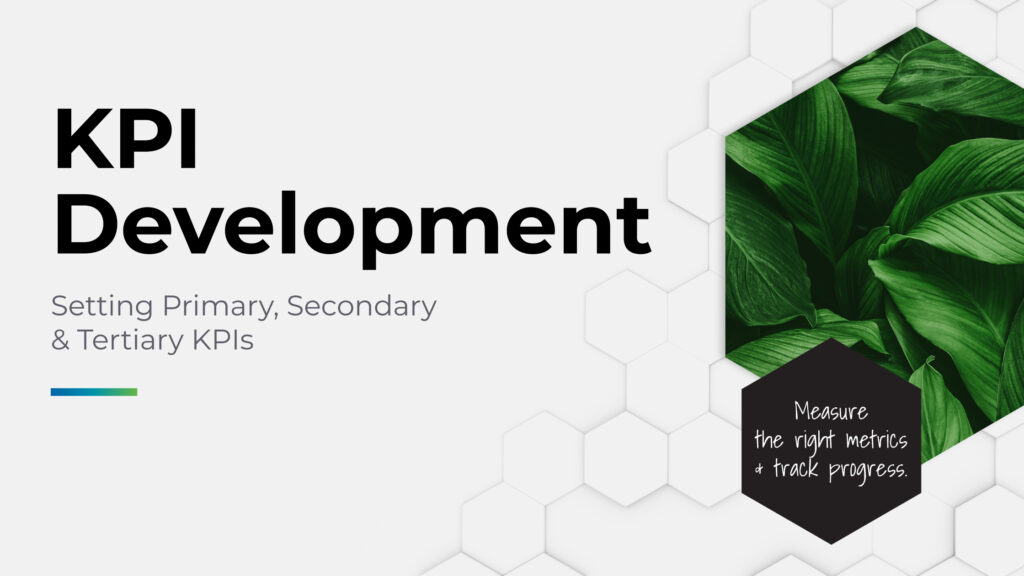We regularly meet B2B marketers who excitedly say, “Look at all my website form submissions! I’ve got so many leads!”
But the tough news is that website form submissions and leads are not always the same thing.
Let’s dissect the key differences, so you can optimize your B2B website conversions for greater engagement. We’re covering:
- Different types of website form submissions
- 5 ways misinterpreting website form submissions will hurt sales and marketing KPIs
- Why lead scoring is essential and practical steps to implement it effectively
- Strategies to bridge the gap between sales and marketing for maximum conversion
Website Form Submissions are NOT Created Equal
When someone completes a form on your website, they are communicating some kind of intent, yes. But what intent?
It’s a grave mistake to assume that every website form completion communicates the intent to purchase your product/service—it definitely does not.

For most B2B brands, there are four common types of website form submissions to be analyzed closely.
Here’s a deeper look to examine these examples more closely:
1. Content Download
Interest Level: They’re looking for information, not necessarily a solution, and certainly not inviting a hard sales pitch.
They might be in the early stages of understanding their problem, or maybe they’re just browsing to expand their knowledge.

Actionable Insight: Follow up with more educational content to nurture them further. Think eBooks, whitepapers, or blog posts that delve deeper into the topic they showed interest in.
In this situation, the goal is to guide them through the awareness stage (don’t rush!) and gradually shift into positioning your solution as the answer to the problem they have.
2. Webinar Signup
Interest Level: This heavily depends on the webinar’s focus. If they signed up for a webinar topic that’s overtly about your product, that indicates higher intent. However, people who sign up for webinars on a more general industry topic are only demonstrating a lower intent.

Actionable Insight: Tailor your follow-up based on the webinar’s focus. For product-specific webinars, follow up with detailed product information, case studies, or even a demo invitation.
For general interest webinars, share additional educational materials and then invite them to more product-focused events.
3. Newsletter Signup
Interest Level: This shows broad interest in your brand, but that interest lacks specificity, which means it can’t be categorized as a high-quality lead.
Signing up for a newsletter shows that they want to stay informed about what you’re up to—it does not show buying intent for a specific product or service.

Actionable Insight: Restructure your newsletter signups to support segmentation so you can personalize content based on their most relevant interests.
Pay close attention to email analytics so you can gather more data about their preferences over time. Provide varied content – company news, industry insights, and occasional product highlights – to maintain engagement and slowly direct them toward more specific interests.
4. Demo Request
Interest Level: This indicates very high interest in what you’re offering. They want a closer look at your product and are likely considering a purchase. This is a strong signal of intent.

Actionable Insight: Send these directly to sales, but be prepared for some early-stage inquiries. Ensure your sales team is ready to provide a thorough and engaging demo experience.
In many B2B contexts, demo requests sometimes come quite early in the buying journey, so be prepared to nurture these leads for the long haul if they’re not ready to buy immediately. Use this opportunity to showcase the value of your product and build a relationship.
5 Ways Misinterpreting Website Submissions Will Hurt Sales & Marketing KPIs
Categorizing every website form submission as a lead creates significant downstream impact to the entire sales and marketing organization. Here’s why:
- Massive waste of time. Successful businesses must optimize the time and efforts of its employees—this is the exact opposite of what happens when the sales team is told someone is a “lead” too early in the customer journey.
The sales team winds up chasing people who, frankly, are not ready to hear about your offer yet. Every moment spent on these disinterested prospects is a moment not spent on those who are ready to make a buying decision.
How to Map Your Customer’s Journey
Explore our comprehensive guide on creating customer journey maps. Learn practical steps to understand and enhance your customer’s path. Be informed.
- Erodes internal trust. Due to the friction encountered when they reach out to “leads” who have not been sufficiently qualified, the sales team starts to lose faith in the marketing team’s ability to deliver the goods.
Rather than a unified organization cohesively moving toward a single goal, internal teams lack trust, which impairs communication and collaboration.
- Fractured trust turns into resentment. Left unchecked, the internal fracture between sales and marketing will keep growing until they’re two sides of a broken zipper—stuck, unable to function at their best, and blaming one another for their predicament.
Sales blames marketing for bad leads. Marketing blames sales for not closing deals. Everyone’s grumbling and team morale nosedives, which often leads to the departure of A+ talent.
- Conversions? What conversions? MQL to SQL conversion rates will plummet. And every subsequent sales KPI will suffer accordingly.
If those acronyms are new to you…
MQL stands for Marketing Qualified Lead. This person has engaged with your content and shown interest, but is not yet ready to be contacted by the sales team. The initial interest shown by MQLs is exciting (oh the possibilities!) but don’t get ahead of yourself because typically, they’re not ready to buy yet. They need more nurturing via high-value content.
SQL stands for Sales Qualified Lead. This designation is applied when an MQL has been vetted and deemed ready for direct sales engagement. SQLs are often MQLs who have been nurtured and now meet certain criteria (budget, authority, need, timeline) suggesting they’re much closer to a purchasing decision, and therefore ready to interact with the sales team.
KPI Development: Setting Primary, Secondary & Tertiary KPIs
Learn how to set effective primary, secondary, and tertiary KPIs with our KPI development guide. Measure the right metrics and track progress. Read now!
- Diluted brand power. Beyond the internal tensions that will emerge, let’s not forget the significant external implications of mistakenly labeling someone as a “lead” just because they completed a website form:
When unqualified leads are tossed back and forth between marketing and sales, this prospect receives a disjointed and often, annoying user experience. They’re receiving content and sales outreach they don’t want (yet).
And in today’s market, repeatedly creating bad user experiences can tarnish a brand’s reputation in no time.
Understanding the Buyer’s Journey—Touchpoints and Intent
Every website form submission is a puzzle piece, not the whole picture.

When someone fills out a form, it’s crucial to understand where they are in their buyer’s journey and what is being revealed at each touchpoint. Here are some key questions to ask:
Journey Stage
Identify which pieces of content correspond to different stages of the buyer’s journey. For instance, an eBook download might indicate early-stage interest, while a demo request usually suggests they’re further along and more ready to buy.
- What indicates they’re just beginning to recognize the problem?
- What confirms they’re clear on their problem and ready to buy?
- What clearly suggests they’re considering buying YOUR solution?
Content Type
Are they consistently engaging with your webinars, ads, social media posts, content downloads, ROI calculators, and other resources? The more varied their interactions, the higher their interest and potential readiness to move forward. Analyzing their engagement with various content types also supports more detailed marketing personalization, which supports faster conversions.
- What channels are they engaged with, and what behavior patterns are connected to that channel?
- Did they download a competitive features comparison (indicating they might be in-market)?
- Did they read a thought leadership piece (suggesting they’re still researching)?
Stakeholder Role
Look for behaviors like multiple individuals from the same organization visiting your site, frequent visits to product pages, or repeated interactions with high-value content. Track the initial email address from an organization and where a subsequent touchpoint leads to new engagement from additional email addresses from that same organization.
- How can you determine whether this person is an information gatherer, decision-evaluator, or decision-maker?
- What factors suggest they might be part of a buying committee?
What Makes a Lead? Combine Website Form Submissions with Touchpoints Analysis
So this core fact has been established: A website form submission is not necessarily a lead. But what then does make someone a lead?
A true lead (let’s use the right terms and say “MQL”) is someone who has engaged with multiple touchpoints across the buyer’s journey and is ready to be nurtured. Before that, they’re just an email address floating around your CRM.
You don’t want to hear this, but it must be said: In the complex B2B landscape, prospects rarely make a purchase decision after a single interaction.
B2B prospects, particularly in higher investment decisions, need time before they’re ready to speak to the sales team.
They’ll consume various forms of content, attend webinars, download whitepapers, and silently lurk on your social media platforms. All of these touchpoints are critical parts of their buyer’s journey, which should not be rushed.
To the contrary, each interaction should be mined to identify personalization opportunities and determine when an MQL is ready to be handed off to sales.
The Art of Lead Scoring
To accurately identify MQLs, you need a robust lead scoring methodology that assigns values to various actions and interactions, helping to determine where each prospect stands in their journey and how likely they are to convert.
Lead scoring is not optional.
That bears repeating for our friends in the back: Lead scoring is not optional.

Protocols for Lead Scoring
Step 1: Define key actions.
Determine which actions are most indicative of buying intent. High-value actions might include attending a product-specific webinar, requesting a demo, or downloading a case study.
Step 2: Assign point values.
Give each action a score based on its importance. For example, a demo request might be worth 50 points, while a blog post read might be worth 5 points.
Step 3: Set an MQL threshold.
Define what score qualifies as an MQL. This threshold should reflect a combination of actions that indicate a high level of interest and readiness to engage with your sales team.
Step 4: Review and adjust.
Continuously review the effectiveness of your scoring system and adjust as necessary. Market conditions change, and so do buyer behaviors, so your lead scoring model should be flexible and dynamic. Standardize a regular review of your scoring system review to maintain effectiveness.
Practical Steps for Successful Lead Scoring
Implementing a lead scoring system might sound like a hassle, but trust us, it’s a game-changer.
Get started with these practical steps and you’ll see the strategic advantage of using lead scoring to cut through the noise so your team can focus on high-quality prospects.
1. Map the Buyer’s Journey
Understand the typical path your prospects take from awareness to decision. Identify the key touchpoints and interactions that signal movement through this journey.
2. Develop a Scoring Matrix
Create a matrix that assigns points to different actions based on their value. Include both online and offline interactions for a comprehensive view of each prospect’s engagement.
3. Integrate with Your CRM
Ensure your lead scoring model is integrated with your CRM system so that scores are updated in real time and visible to both marketing and sales teams.
4. Train Your Teams
Educate your marketing and sales teams on how the lead scoring model works and how to use the scores to prioritize follow-ups and engagement.
5. Monitor and Refine
Regularly analyze the performance of your lead scoring model. Look at conversion rates, sales feedback, and other metrics to identify areas for improvement.
Bridging the Gap Between Sales and Marketing
The key to smoothing out the working relationship between marketing and sales lies in solid communication and process alignment. Both teams need to be on the same page about what defines a lead and how each lead should be handled.
Here’s how to bridge that gap and turn your whole team into a well-oiled machine:
- Hold regular syncs between sales and marketing to discuss lead quality and conversion rates.
These full-team huddles are essential. Share insights, celebrate wins, and address challenges head-on, to keep both teams aligned on goals and strategies.
- Develop a shared definition of what constitutes an MQL and an SQL.
Disconnected performance metrics between sales and marketing is the kryptonite of many organizations. Teams need to agree on metrics that reflect the quality and progress of leads through the funnel.
No, this isn’t just semantics—it’s about ensuring everyone speaks the same language. Do the hard work of laying all the important factors on the table and outlining clear, concrete criteria for what makes an MQL and SQL so there’s no ambiguity.
- Create a system for sales to provide feedback on lead quality, which marketing can use to refine lead generation strategies.
This feedback loop is your secret weapon. Sales should regularly report back on the leads they receive—what’s working, what’s not, what objections can marketing help to address on the front-end, etc. This symbiotic relationship will make the lead gen process sharper and more effective.
- Use collaborative tools and platforms to ensure transparency and ease of communication.
Tools like shared CRMs, project management software, and communication platforms help to keep everyone in the loop and reduce miscommunication.
- Conduct joint training sessions where both teams can learn about each other’s processes, challenges, and tools.
Cross-training fosters empathy, enhances the quality of team collaboration, and can flag potential roadblocks so that they can be addressed proactively.
- Recognize and celebrate joint successes.
When a lead generated by marketing converts into a sale, make sure to celebrate that win together. Sales doesn’t accomplish conversions in a vacuum. Acknowledging the mutuality in the relationship between sales and marketing fosters a sense of shared purpose and boosts morale for additional optimizations and wins.
- Build clear, documented processes for how leads are handed off between teams. A casual email or Slack message that could easily be missed is not a reliable structure. Create a formal and evergreen process to ensure everyone knows their role and what’s expected at each stage of the lead’s journey.
Website Form Submissions Are Just The Beginning
In the world of B2B marketing, a website form submission is just the tip of the iceberg.
By understanding the nuances of each type of website form submission and implementing a strong lead scoring system, you can ensure that your sales team is only following up with high-quality leads.
Quality over quantity is not just a mantra; it’s a necessity.
So, next time you see a website form submission, remember that it’s just a starting point. Treat it as such, and you’ll see a significant improvement in your lead conversion rates and overall sales success.
Summary
- Website form submissions don’t automatically translate to high-quality leads – quality over quantity is key.
- Defining all website form submissions as “leads”wastes time, erodes internal trust between sales and marketing, hurts the most high-impact performance metrics, and dilutes the brand reputation.
- Assess the buyer’s journey and the type of website form submission to gauge user intent and readiness.
- Implement a robust lead scoring system to prioritize high-quality leads.
- It’s essential to foster communication and process alignment between sales and marketing for better lead conversion.






